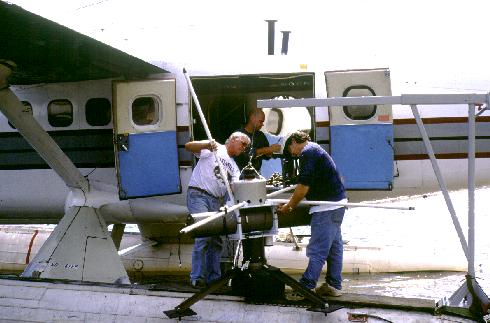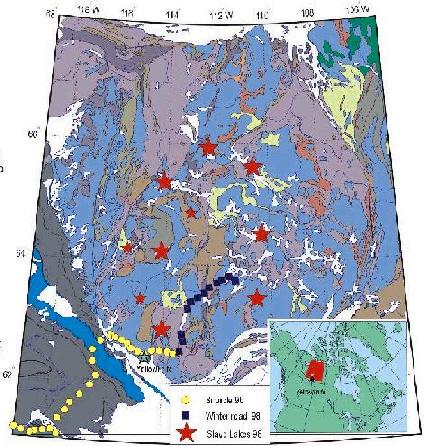LITHOPROBE Slave-Northern Cordillera Lithosphere Evolution (SNORCLE) Transect
Slave Lakes EM Experiment

Helmut and Bill construct a shallow-water EM instrument in preparation
for deploying it in the middle of one of the lakes.
In the background Rob is supervising.
EM leaders.....
Collaborators.....
Financial Sponsors.....
- Geological Survey of Canada
- Natural Sciences and Engineering Research Council of Canada (Lithoprobe)
- U.S. National Science Foundation
Project Overview.....
A better understanding of how the mantle participated in the growth and
stabilization of ancient cratons is central to the study of the evolution of
the continents. There are several current and competing models for the
formation of Archean and Proterozoic cratons. However, these models are
often in conflict, reflecting the limited extant data that can sense the deep
structure beneath continents. A program of multi-disciplinary geoscientific
studies of Archean cratonic roots is required to remedy fundamental
deficiences in our knowledge base so that we can better address
continental mantle issues.
Electromagnetic studies have demonstrated that they can contribute
significantly to such studies by defining both the base of the lithosphere
(as determined by the onset of partial melt in the asthenosphere, or
approximately the locus of the present-day 1300 C isotherm) and by
determining structural features (both in a lateral and a vertical sense)
within the mantle. In addition, electromagnetic studies can define the fossil
foliation and lineation direction from the strike of mantle electrical
anisotropy. Thus, electromagnetic methods should serve as a key
component of modern continental studies that complement and augment the
information provided by seismic methods, particularly shear wave splitting
studies.
This research is a major add-on component of a multi-disciplinary
effort that is currently underway as part of the Canadian Lithoprobe program.
We are proposing to utilize proven oceanic magnetotelluric
technology in strategically-located lakes on the Archean Slave province
to conduct very deep magnetotelluric probing of cratonic root structure.
Lakes offer a thermally and chemically stable environment for long period
electromagnetic measurements that cannot be matched on land. To be specific,
we propose to characterize electrically the root of the southern and central
portion of the Slave craton, including its depth extent, any lateral variation
in structure, and its deep electrical anisotropy. We will combine our results
with ongoing Canadian broadband magnetotelluric, reflection seismic,
passive seismic (especially shear wave splitting), and related geological
studies in an effort to improve our overall understanding of deep cratonic
structure.
The choice of the Slave craton is determined by a number of factors,
including:
-
The southern and central parts of the Slave display no geological evidence
for post-Archean deformation, and hence offers a very high probability
of preserving Archean deep structure in the cratonic root. This is
not true of the northern Slave, where the McKenzie and Franklin dike
emplacements document mantle plume activity in the 800-1300 Ma timeframe,
and is far from a ubiquitous feature of other Archean cratons.
-
Recent SNORCLE EM work at the southwestern corner of the Slave on the
Anton terrane by one of us (AGJ) has demonstrated that MT can image the
lithosphere and that the lithosphere is thick (>200 km). Furthermore,
the Anton terrane shows no conducting lower crust, in contrast to all
other Archean terranes, including the Superior, Kaapvaal, and Siberian.
A conducting lower crust can limit resolution of structural features
in the underlying craton, but the SNORCLE result suggests that this problem
will not occur beneath the Slave. This offers the high probability of
obtaining good quality electrical images of the old cratonic root.
-
Isotopic evidence (Pb and Nd) suggests that the Slave craton is
comprised of a melange of crustal blocks welded together at 2.6
Ga. If these crustal blocks had different distinct attached
lithospheres, there should be observable differences in electrical
anisotropy magnitudes and directions in the root.
-
The Slave craton is the oldest of a series of Archean cratons that extend
from northwest to southeast in the Canadian shield, and in fact
hosts the oldest rocks dated on Earth (>4000 Ma). This offers the
possibility of characterizing an end member craton for comparison
to other, younger regions.
-
Through Lithoprobe activities along the SNORCLE transect, there is an
opportunity for both international co-operation with Canadian
investigators, and access to a great body of geoscientific
information that will be acquired by them. Particularly, a number
of complementary electromagnetic studies are planned, and the data
from these will be available for joint interpretation with our data.
These data will provide invaluable constraints on surface structure,
but are not generally available on other cratons at the spacing
and over the area that are available through SNORCLE.
-
Work in the Slave is very cost-effective compared to activity on cratons
located outside North America. Furthermore, our proposed work is of
sufficient interest to Lithoprobe that all field costs will be
supported by them, reducing the bottom line for the Slave study.
This advantage would be lost by moving the study to another
Canadian craton.
-
The Geological Survey of Canada and the Government of the Northwest
Territories are just completing an extensive geological study in the
central part of the craton under the auspices of the Canadian
NATMAP (National Mapping) program. Thus, extensive geological
data will be available to us.
-
A passive teleseismic study is currently taking place on the Slave craton,
and we will be able to compare electrical structure with seismic
parameters such as mantle anisotropy direction and amplitude.
-
There is a very active diamond exploration program on the Slave which
will give us access to mantle geological and geochemical
information from kimberlite pipes, as well as the possibility of
logistical assistance.
We view this work as the first phase of a larger scale effort to
electromagnetically characterize Archean cratonic mantle where co-located
high quality passive seismic experiments have either taken place,
are taking place, or are planned. Deep electromagnetic methods have not
been applied as much as equivalent passive seismic ones, and accordingly
we view this work as a pilot project, although the instrumentation, methods
and analyses are all well-proven. Should this study be as
successful as we expect, then later research will focus on other cratons,
such as the Superior or Kaapvaal.
EM Activities.....
1998 installation

Press for full-sized map (178 Kb - JPG) or download CorelDraw
CDR file (4.8 Mb) or a
CMX file (2.4 Mb).
|
Shallow-water instruments were placed in 10 lakes on the Slave craton.
The locations are shown by the red stars on the map.
The lakes are:
Northern Line:
Point Lake, Contwoyto Lake, Rockinghorse Lake
Middle Line:
Indin Lake, Snare Lake, Big Lake, Lac de Gras
Southern Line:
Wheeler Lake, Duncan Lake, Lac Tet d'Ours
The lakes with the small red stars are those where the electric fields may
go off-scale due to a software bug found after their installation.
Other sites are from the
SNORCLE 1996 MT data acquisition (yellow circles)
and the
1998 Winter Road experiment
(black squares)
|
Pictures of construction, deployment and retireval
(JPEG format: 200Kb - 300Kb each)
Links...
 MTNet Home Page
MTNet Home Page
 Alan's Home Page
Alan's Home Page
Alan G Jones / 22 April 2006 /
 alan-at-cp.dias.ie
alan-at-cp.dias.ie



 MTNet Home Page
MTNet Home Page
 Alan's Home Page
Alan's Home Page
 alan-at-cp.dias.ie
alan-at-cp.dias.ie